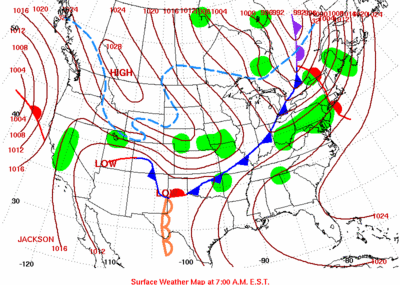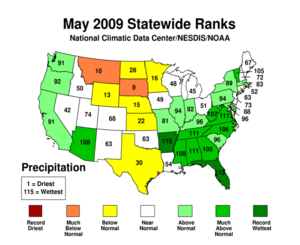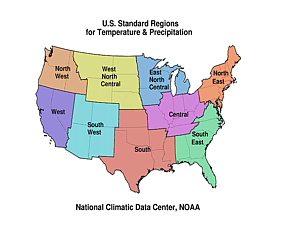SOUTHEAST DROUGHT
According to the Southeast
Regional Climate Center, much of the region received above
normal precipitation totals for May, with many local records
broken. Below normal precipitation totals for the month were
confined to small portions of eastern and central North Carolina,
central Georgia, and the western panhandle of Florida. The heavy
precipitation observed across much of the region provided continued
relief from the lingering drought across small portions of the
Southeast. The area of extreme drought (D3) in southwestern Florida
was reduced to moderate drought (D1). The small region of moderate
drought (D1) in western North Carolina and extreme northeast
Georgia disappeared, although abnormally dry conditions persisted
across portions of the region. A few groundwater monitors
southwestern North Carolina indicated that water table levels there
had not fully recovered.
SOUTHERN REGION DROUGHT
As noted by the Southern
Regional Climate Center, approximately half of the region
experienced above-normal precipitation totals, while the other half
had below-normal rainfall. Most of western Oklahoma and almost all
of Texas were drier than normal, with a majority of stations
reporting less than half the monthly normal. The driest areas of
the Southern Region included eastern Texas, northern Texas and
western Oklahoma, where precipitation totals ranged from 5 to 50
percent of normal. The drought pattern in the Southern Region for
the month of May was only slightly different from that of the
previous month. Over the course of May, there was some reduction of
extreme and exceptional drought in southern Texas and some
improvement in the Trans Pecos climate division of Texas, where
above normal monthly precipitation totals were observed. In north
central Texas, a small bullet of extreme drought remained from last
month; however, there was a significant reduction in the area of
severe drought that surrounded it.
MIDWEST DROUGHT
As explained by the Midwest
Regional Climate Center, precipitation varied from below 50
percent of normal in northwest Iowa, central Minnesota, and
northwest Wisconsin to nearly 200 percent of normal in eastern
Kentucky and south of the confluence of the Mississippi and Ohio
Rivers. Northwest Minnesota was also well above normal for the
month. Dry conditions persisted across southern Minnesota,
northwest Wisconsin, and Upper Michigan in May extending the
drought in those areas.
Prolonged drought in northern Wisconsin has resulted in some lakes
reaching their lowest levels in 70 years and has contributed to a
surge in forest fires (Milwaukee Journal Sentinel, 5/23).
HIGH PLAINS REGION DROUGHT
As noted by the High Plains
Regional Climate Center, May 2009 was a month of record-setting
dryness across the High Plains region as a weak precipitation
pattern dominated. Most of the region received less than 70 percent
of normal precipitation and large swaths received less than 50
percent of normal precipitation. Ultimately, several locations
across the region recorded the driest May on record. This month's
extreme dry location was Wamego 4W, Kansas which broke a 108-year
record by receiving only 0.52 inch (13.2 mm) of precipitation. The
old record of 0.92 inch (23.4 mm) was set back in 1901. While the
vast majority of the High Plains region was dry, western Colorado
and small portions of Kansas, Nebraska, and North Dakota received
above-normal precipitation. With a dry May and dry weather in
earlier months, many locations were 3-6 inches (76-152 mm) below
normal for the year. In eastern Nebraska, the Lincoln airport
station had the second driest January-May in the 44-year record
while the Omaha airport station was fifth driest out of 74 years.
The combination of cool temperatures and ample soil moisture staved
off drought conditions, but stress on some emerging crops became
evident this month. Abnormally dry conditions (D0) in eastern
Nebraska and north-central Kansas expanded to include much of South
Dakota and a portion of the Nebraska panhandle. In the western
portion of the High Plains region, drought conditions improved. In
south-central Colorado, moderate drought conditions (D1) were
downgraded to D0 and portions of the D0 in both Wyoming and
Colorado were erased.
WESTERN DROUGHT
As summarized by the Western
Regional Climate Center, the precipitation pattern for May was
a mix of above and below normal. May was wetter than usual for most
of Arizona, southwest New Mexico, Northern California, the coastal
Pacific Northwest, and a large area centered around the Four
Corners. Most of New Mexico and Utah were below normal. Conditions
were especially dry in much of Nevada and in southern California,
as well as all of Montana and most of Wyoming. It was the third
driest May on record in Billings, Montana going back to 1948. Parts
of the Southwest experienced the wettest May on record while other
Southwest locations received little or no rain.
Throughout the first week of May, numerous Alaskan Rivers flooded
due to ice jams, inundating many towns. The Yukon River in Eagle
rose to 20 feet above flood stage, which was 10 feet above the old
record set in 1937.
California: End-of-May data provided by the
California State Climatologist indicated that "statewide reservoir
storage, precipitation, and water supply conditions have improved
somewhat in May; however, allocation estimates to state and federal
water contractors are expected to be near record lows for 2009, and
reliance on local groundwater has and will continue to be above
average. Runoff for this water year is expected to be much lower
than average for the third year in a row, and drought conditions
remain serious across the state." (California's
Drought Update, Drought Operations Center, 5/29/09)
NORTHEAST DROUGHT
As noted by the Northeast
Regional Climate Center, precipitation totals were above normal
in much of the region, breaking a string of dry months. The
Northeast, on average, received 4.67 inches (118.6 mm) of rain,
which was 117 percent of normal. While Vermont was the driest state
in April, it was the wettest in May, with 144 percent of the normal
May rainfall amount. Connecticut (87 percent) and Rhode Island (79
percent) were the driest states this month. Only a small portion of
northeastern Pennsylvania, northern New Jersey, and a bit of New
York along the Pennsylvania-New Jersey border had abnormally dry
conditions according to the USDM dated June 2, 2009. For spring
(March-May), the region's three-month precipitation average was
10.30 inches (261.6 mm), or 93 percent of normal. West Virginia
(105 percent), Maryland (102 percent) and Delaware (100 percent)
were the only states at or above normal. With 75 percent of the
normal spring precipitation amount, Connecticut was the driest
state.
|


 weather pattern
over the contiguous United States for May began
with a generally westerly flow in the atmosphere that shifted
northward by the end of the month. Strong low pressure systems and
associated fronts, embedded in this west-to-east circulation,
brought precipitation
to parts of the West and widespread precipitation to the
Mid-Mississippi Valley to East Coast, which especially benefitted
the drought and
abnormally dry areas in the east (June 2 USDM
versus April 28
USDM).
weather pattern
over the contiguous United States for May began
with a generally westerly flow in the atmosphere that shifted
northward by the end of the month. Strong low pressure systems and
associated fronts, embedded in this west-to-east circulation,
brought precipitation
to parts of the West and widespread precipitation to the
Mid-Mississippi Valley to East Coast, which especially benefitted
the drought and
abnormally dry areas in the east (June 2 USDM
versus April 28
USDM).



















 NOAA's National Centers for Environmental Information
NOAA's National Centers for Environmental Information
